- Clone
- WM15 (See other available formats)
- Regulatory Status
- RUO
- Workshop
- IV M44
- Other Names
- Aminopeptidase N, APN, gp150
- Isotype
- Mouse IgG1, κ
- Ave. Rating
- Submit a Review
- Product Citations
- publications
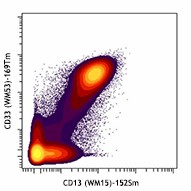
-

Human PBMCs stained with 152Sm anti-CD13 (WM15) and 169Tm anti-CD33 (WM53). Total cells, excluding lymphocytes, are displayed in the analysis. Data provided by DVS Sciences.
| Cat # | Size | Price | Quantity Check Availability | Save | ||
|---|---|---|---|---|---|---|
| 301717 | 100 µg | $129 | ||||
CD13 is a 150-170 kD type II transmembrane glycoprotein also known as aminopeptidase N, APN, and gp150. This zinc metallopeptidase is expressed as a homodimer on granulocytes, myeloid progenitors, endothelial cells, epithelial cells and subset of granular lymphoid cells. It is not expressed on platelets or erythrocytes. CD13 is thought to be involved in the metabolism of many regulatory peptides and functions in antigen processing and the cleavage of chemokines such as MIP-1. CD13 serves as the cellular receptor for Coronavirus.
Product DetailsProduct Details
- Verified Reactivity
- Human
- Reported Reactivity
- Baboon, Chimpanzee, Cotton-topped Tamarin
- Antibody Type
- Monoclonal
- Host Species
- Mouse
- Formulation
- Phosphate-buffered solution, pH 7.2, containing 0.09% sodium azide and EDTA.
- Preparation
- The antibody was purified by affinity chromatography.
- Concentration
- 1.0 mg/ml
- Storage & Handling
- The antibody solution should be stored undiluted between 2°C and 8°C.
- Application
-
FC - Quality tested
CyTOF® - Verified - Recommended Usage
-
This product is suitable for use with the Maxpar® Metal Labeling Kits. For metal labeling using Maxpar® Ready antibodies, proceed directly to the step to Partially Reduce the Antibody by adding 100 µl of Maxpar® Ready antibody to 100 µl of 4 mM TCEP-R in a 50 kDa filter and continue with the protocol. Always refer to the latest version of Maxpar® User Guide when conjugating Maxpar® Ready antibodies.
- Application Notes
-
Additional reported applications (for the relevant formats) include: inhibition of tumor-cell invasion and blocking of aminopeptidase activities2,3, and immunohistochemical staining of acetone-fixed frozen tissue sections5. WM15 does not recognize formalin-fixed or paraffin-embedded tissue sections5. The LEAF™ purified antibody (Endotoxin < 0.1 EU/µg, Azide-Free, 0.2 µm filtered) is recommended for functional assays (Cat. No. 301708). For highly sensitive assays, we recommend Ultra-LEAF™ purified antibody (Cat. No. 301723 and 301724) with a lower endotoxin limit than standard LEAF™ purified antibodies (Endotoxin < 0.01 EU/µg).
- Additional Product Notes
-
Maxpar® is a registered trademark of Standard BioTools Inc.
-
Application References
(PubMed link indicates BioLegend citation) -
- Knapp W, et al. 1989. Leucocyte Typing IV. Oxford University Press. New York.
- Saiki I, et al. 1993. Int J Cancer. 54:137. (Block)
- Rosenzwajg M, et al. 2000. Blood 95:453. (Block)
- Kawase M, et al. 2008. J Virol. 83:712. (Block) PubMed
- Di Matteo P, et al. 2011. J. Histochem. Cytochem. 59:47. (IHC)
- RRID
-
AB_2563717 (BioLegend Cat. No. 301717)
Antigen Details
- Structure
- Zinc metallopeptidase, type II integral membrane glycoprotein, 150-170 kD
- Distribution
-
Granulocytes, monocytes, myeloid progenitors, endothelial and epithelial cells, granular lymphocyte subset
- Function
- Zinc-binding metalloproteinase, antigen processing, cleaves MIP-1 chemokine
- Ligand/Receptor
- Coronavirus receptor
- Cell Type
- Endothelial cells, Epithelial cells, Granulocytes, Hematopoietic stem and progenitors, Lymphocytes, Mesenchymal Stem Cells, Monocytes, Neutrophils
- Biology Area
- Immunology, Stem Cells
- Molecular Family
- CD Molecules
- Antigen References
-
1. Shipp M, et al. 1993. Blood 82:1052.
2. Larsen S, et al. 1996. J. Exp. Med. 184:183. - Gene ID
- 290 View all products for this Gene ID
- UniProt
- View information about CD13 on UniProt.org
Related FAQs
- Can I obtain CyTOF data related to your Maxpar® Ready antibody clones?
-
We do not test our antibodies by mass cytometry or on a CyTOF machine in-house. The data displayed on our website is provided by Fluidigm®. Please contact Fluidigm® directly for additional data and further details.
- Can I use Maxpar® Ready format clones for flow cytometry staining?
-
We have not tested the Maxpar® Ready antibodies formulated in solution containing EDTA for flow cytometry staining. While it is likely that this will work in majority of the situations, it is best to use the non-EDTA formulated version of the same clone for flow cytometry testing. The presence of EDTA in some situations might negatively affect staining.
- I am having difficulty observing a signal after conjugating a metal tag to your Maxpar® antibody. Please help troubleshoot.
-
We only supply the antibody and not test that in house. Please contact Fluidigm® directly for troubleshooting advice: http://techsupport.fluidigm.com/
- Is there a difference between buffer formulations related to Maxpar® Ready and purified format antibodies?
-
The Maxpar® Ready format antibody clones are formulated in Phosphate-buffered solution, pH 7.2, containing 0.09% sodium azide and EDTA. The regular purified format clones are formulated in solution that does not contain any EDTA. Both formulations are however without any extra carrier proteins.
Other Formats
View All CD13 Reagents Request Custom ConjugationCompare Data Across All Formats
This data display is provided for general comparisons between formats.
Your actual data may vary due to variations in samples, target cells, instruments and their settings, staining conditions, and other factors.
If you need assistance with selecting the best format contact our expert technical support team.
-
APC anti-human CD13
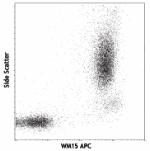
Human peripheral blood lymphocytes, monocytes and granulocyt... -
PE anti-human CD13
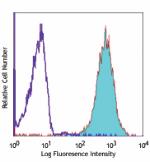
Human peripheral blood granulocytes stained with WM15 PE -
Purified anti-human CD13
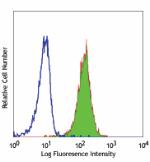
Human peripheral blood granulocytes stained with purified WM... -
Brilliant Violet 421™ anti-human CD13

Human peripheral blood granulocytes were stained with CD13 (... -
APC/Cyanine7 anti-human CD13

Human peripheral blood granulocytes stained with CD13 (clone... -
PE/Cyanine7 anti-human CD13
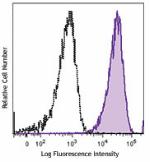
Human peripheral blood granulocytes were stained with CD13 (... -
PerCP/Cyanine5.5 anti-human CD13

Human peripheral blood granulocytes were stained with CD13 (... -
Purified anti-human CD13 (Maxpar® Ready)
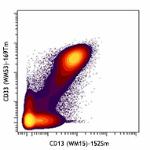
Human PBMCs stained with 152Sm anti-CD13 (WM15) and 169Tm an... -
PE/Dazzle™ 594 anti-human CD13
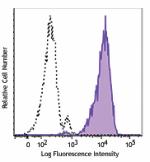
Human peripheral granulocytes were stained with CD13 (clone ... -
PE anti-human CD13

Typical results from human peripheral blood granulocytes sta... -
Brilliant Violet 711™ anti-human CD13
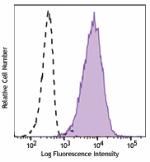
Human peripheral blood granulocytes stained with CD13 (clone... -
Ultra-LEAF™ Purified anti-human CD13
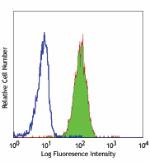
Human peripheral blood granulocytes stained with Ultra-LEAF™... -
Brilliant Violet 785™ anti-human CD13
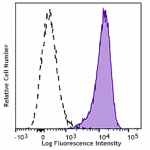
Human peripheral blood granulocytes were stained with CD13 (... -
Brilliant Violet 605™ anti-human CD13

Human peripheral blood granulocytes were stained with CD13 (... -
TotalSeq™-A0364 anti-human CD13
-
TotalSeq™-B0364 anti-human CD13
-
TotalSeq™-C0364 anti-human CD13
-
PE/Cyanine7 anti-human CD13

Typical results from human peripheral blood granulocytes sta... -
TotalSeq™-D0364 anti-human CD13
-
APC anti-human CD13
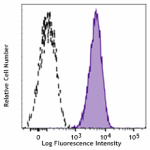
Typical results from human peripheral blood granulocytes sta... -
PE/Dazzle™ 594 anti-human CD13

Typical results from human peripheral blood granulocytes sta... -
PerCP/Cyanine5.5 anti-human CD13
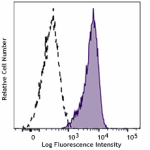
Typical results from human peripheral blood granulocytes sta... -
GMP APC anti-human CD13
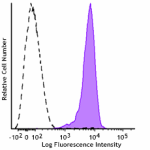
Typical results from human peripheral blood granulocytes sta... -
GMP PE anti-human CD13
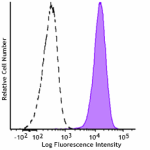
Typical results from human peripheral blood granulocytes sta... -
PE/Fire™ 810 anti-human CD13
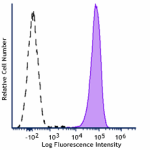
Human peripheral blood granulocytes were stained with anti-h... -
GMP PE/Cyanine7 anti-human CD13
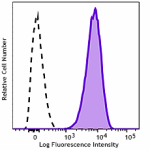
Typical results from human peripheral blood granulocytes sta... -
GMP PE/Dazzle™ 594 anti-human CD13
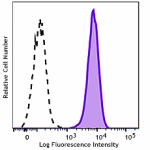
Typical results from human peripheral blood granulocytes sta... -
GMP PerCP/Cyanine5.5 anti-human CD13
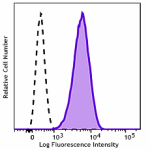
Typical results from human peripheral blood granulocytes sta...
 Login/Register
Login/Register 













Follow Us